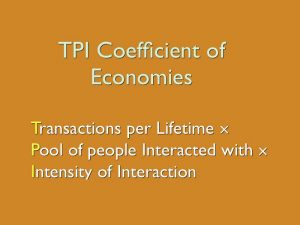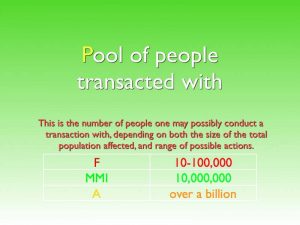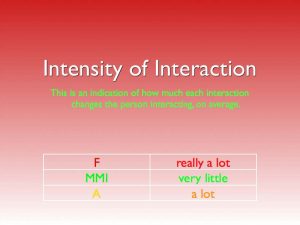I have been discussing the Attention Economy as new economy, but it seems that many readers still do not quite get what I mean by a new economy. If we think back to prehistory, it is obvious that the economy which is generally studied in school or university economics courses (which I reefer to as the MMI economy — see below) did not exist. There were no markets, no money, and little or nothing that could be called industrial factories. So the economy having all these features came into existence only at some later time. In turn that implies, in contrast to how economists (and, indeed, most of us) frequently act, think and write, there is no need to view it as inevitable or permanent. It came into existence at a specific time in human history, and just as we grew into it, we may “outgrow” it. It can quite possibly and logically reach the end of its line. This would not necessarily be through failure, but in fact even more likely through success. Afterwards, human energies will head increasingly in a different direction.
I do not view the new economy as necessarily morally superior in any way, but rather as distinctly different in goals, rules, practices and internal mores. It’s primary item of desirability and scarcity is of course neither material goods nor money, but attention, as I have repeatedly emphasized.
Let me clarify in one other way, as well. For many, the only conceivable alternative possibility to present-day capitalism would be socialism or communism, but to my mind all three are variants of the same industrial system, not distinctly different systems at all. The Attention Economy is distinctly different.
So what has led to the rise of the Attention Economy now? To examine that it is useful to have an idea about how economies in general come into existence, begin to meet their implicit goals, and through their prior development to offer openings for a new system’s taking up of human energies and desires they have little means of fulfilling.
A DEFINITION OF AN ECONOMY, IN GENERAL:
An economy is a system of human activities that ties one or more societies together around the allocation of what is most scarce and desirable. That changes because a given economy can do sufficiently well at achieving its implicit goals, leaving what was once most desirable now to be taken for granted. Every economy gets its start at some point in time and space, and has to expand from then and there, if it is ever to have any significance. Thus every economy must have some mode of growth, but successful growth eventually leads it to some point when it has so altered the conditions that gave rise to it, that new directions are more compelling.
As an economy succeeds, it does pretty well in satisfying the needs that originally set it in motion. Some kind of consolidation takes place, in the areas in which it is strongest. That allows various kinds of new activities to be tried, and openings to be seized by those with different interests and motives from those who set the now dominant economy in motion, and who are still most tied to its ways.
The Money and Market-based Industrial (MMI) Economy
I have earlier discussed how the MMI economy emerged from the feudal economy that preceded it in Western Europe. Whereas feudalism’s implicit goal was security against outside and, later, internal armed raiders, MMI’s own implicit goal (in condensed form) was something like the following: to provide a diverse array of goods to support a growing population in some degree of comfort; that required organizing and routinizing the work of producing material goods and distributing these through market mechanisms. Over the course of centuries the MMI economy expanded in the area it covered and how intensely it affected people’s lives, and it kept becoming more efficient at achieving its goal. Eventually, the goal was more or less met, for a large swath of people. New products would lead people to feel new needs, but not unlimited new needs. You can change your active desires only so fast.
So about 1930, when you take into account farming, etc., net material production employment began to decline, worldwide. That was one way a space opened up that an attention economy could begin to fill, and that filling began, along with a number of other effects (such as the Great Depression, World War II, the arms race, etc.)
In the aftermath of WWII, in the US anyway, these further developments occurred:
1 More-or-less universal high-school education took place in larger and larger high schools; tertiary education, including large junior or community college campuses and enormous state university enrollments also burgeoned.
2 The popularity of phonograph records, network radio and TV, as well as paperback books, meant the whole society began to have a web of stars in common, which had not been possible to the same degree before.
3. New, so-called information technologies, added ever newer modes of attention paying and then attention seeking behavior. Proliferating office work, again more and more interconnected by a whole series of new technologies became a major site of attention seeking, paying and receiving.
Taken together these three developments meant that young people grew up in a world in which they had plenty of role models for attention getting: the stars of various media. They also had a built in situation (large high schools) in which they could be part of large audiences, or could seek to become stars in those very milieux, in all the different types of audience-related activities, from sports to school politics, to simple in-group popularity to extra-curricular activities like forming rock or rap groups, etc. As child labor had been outlawed, but child attention –getting activities had not been, there was an even greater impetus to move in those directions. Since then, the ever-new technologies for attention getting have greatly increased seeming opportunities for competing for attention, and as this heated up, the scarcity of attention only added more pressure. In a very preliminary guess I would also put forth that the Implicit Goal of Attention Economy is: to tightly intertwine everyone at the level of mind. But that involves individuals seeking, obtaining and/or paying attention. which is now what is most scarce and desirable. Because it takes some attention even to wish for new material goods, much less acquire, possess and use them, the growing scarcity of attention increases the pressure on the old economy. A growing percentage of the goods that are either bought or lusted after are sought strictly because of their presumed value in attention-getting.
While people who have attention can now draw money to themselves in a variety of ways, that is only because if you pay someone attention, you will automatically be interested in meeting their wants. At present it may be more convenient to express those wants, at times, in monetary terms, but as it gets easier to satisfy wants just through attention, it seems quite likely to me that money will not be seen as a necessity. (In fact, already, the vast majority of people who use the Internet mostly seek only attention and not money; thus the proliferation of blogs, MySpace, Flikr, YouTube videos, comments, statements to listservs, etc. ) Thus, the Attention Economy is a completely different kind of economy, post-industrial, post-market and post-money.
Will this new kind of economy come to dominate more completely, until the old one is pretty completely swallowed up and transformed by it? And if so, how soon? I think the answer is most probably yes, and within no more than a couple of generations, though unexpected developments of many sorts could obviously throw this prediction off. I will argue in future that it would be unwise not to take this prediction seriously, however.




